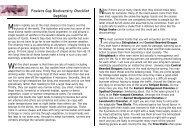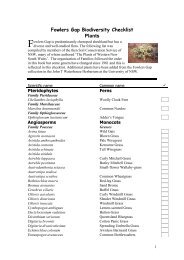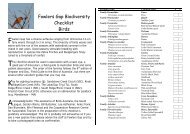2007 Research Reports.pdf - Fowlers Gap Arid Zone Research Station
2007 Research Reports.pdf - Fowlers Gap Arid Zone Research Station
2007 Research Reports.pdf - Fowlers Gap Arid Zone Research Station
Create successful ePaper yourself
Turn your PDF publications into a flip-book with our unique Google optimized e-Paper software.
1.4 Maternal effects in cooperatively breeding chestnut crowned babbler.<br />
Investigators: Andrew F Russell 1,2 , Simon C Griffith 2 , Lucy E Browning 3<br />
1<br />
Department of Animal & Plant Sciences, University of Sheffield, Sheffield S10<br />
2TN, UK,<br />
2<br />
CISAB, Macquarie University, Sydney, NSW 2109,<br />
3<br />
Department of Zoology, University of Cambridge, Cambridge CB2 3EJ, UK.<br />
Mothers are known to exert a strong influence on the growth, survival and reproductive capacity<br />
of offspring in adulthood. Similarly, sibling competition can also exert substantial effects, in<br />
extreme cases resulting in siblicide. Whether and, if so, how mothers reduce sibling competition<br />
and maximise their own fitness is largely unknown. We began an examination of maternal<br />
investment strategies in our population of chestnut-crowned babblers at the UNSW <strong>Arid</strong> <strong>Zone</strong><br />
<strong>Research</strong> <strong>Station</strong> at <strong>Fowlers</strong> <strong>Gap</strong>. Mothers can do a number of things to reduce competition.<br />
They can change clutch size, egg size, hatching asynchrony and sex ratio. We collected data on<br />
these four parameters by removing clutches of eggs from 50 groups and hatching the eggs out in<br />
an incubator. This allowed us to collected detailed data on all parameters. In order to test<br />
experimentally the effect of each of these parameters on maternal fitness, we then cross-fostered<br />
out eggs into different nests from which they came, and in doing we manipulated all four<br />
parameters. This experiment is the first of its kind and will reveal unexplored ways in which<br />
mothers reduce sibling competition and maximise personal fitness.<br />
1.5 Behaviour and ecology of the cooperatively breeding Apostlebird<br />
Investigators: Jonathan Wright 1 , Anahita Kazem 1 , Andrew F Russell 2,3 , Simon C Griffith 3<br />
1<br />
Institute of Biology, NTNU, Trondheim, 7491 Norway,<br />
2<br />
Department of Animal and Plant Sciences, University of Sheffield, S10 2TN,<br />
U.K,<br />
CSIAB, Macquarie University, Sydney, NSW 2109<br />
This long-term study of the apostlebird (Struthidea cinerea) population at <strong>Fowlers</strong> <strong>Gap</strong> has<br />
continued to progress. Over 275 birds have now been caught, individually colour-banded and<br />
bled (for genetic analyses of relatedness), representing approximately 75% of the birds in the<br />
core study area within ~5km of the station. We have succeeded in habituating 71% of these<br />
banded birds to the close presence of human observers, and the last remaining birds will be<br />
habituated in 2008. The ultimate aim here is to get all individuals in the core study area to stand<br />
on electronic balances on demand, so that we can measure short-term changes in body mass and<br />
hence assess state-dependence within- and between-individuals in their behavioural strategies.<br />
We now have 3 years data on the social structure, breeding group size and breeding success,<br />
including detailed GIS mapping of the creek habitat used for nesting. Detailed behavioural<br />
observations and experiments have begun on various topics, such as foraging, vigilance,<br />
mobbing, vocalizations and helping at the nest. Specific data on ‘false-feeding’ behaviour and<br />
individual provisioning strategies during nestling feeding have been collected during <strong>2007</strong> to<br />
compare with earlier data collected by Iain Woxwold (Univ. Melbourne) from another less arid<br />
site far to the southeast. Compared with populations further east, the social structure of the<br />
<strong>Fowlers</strong> <strong>Gap</strong> population of apostlebirds seems to be surprisingly fluid and rather flexible in terms<br />
of breeding group formation and reproductive effort, which both depend heavily on annual<br />
variation in environmental conditions. The large wide-ranging flocks seen during the winter at<br />
<strong>Fowlers</strong> <strong>Gap</strong> appear to constitute ‘clans’ of familiar and possibly related individuals. These nonbreeding<br />
winter flocks fragment in the early spring and form smaller breeding groups of 3 to 15






